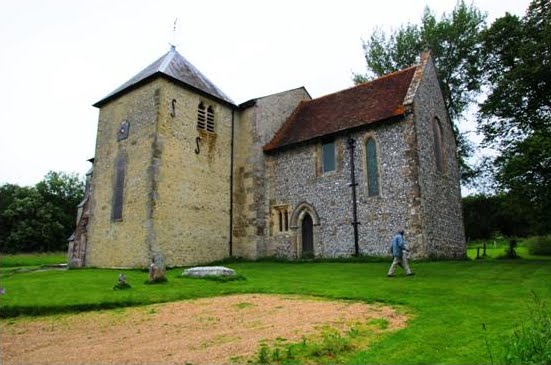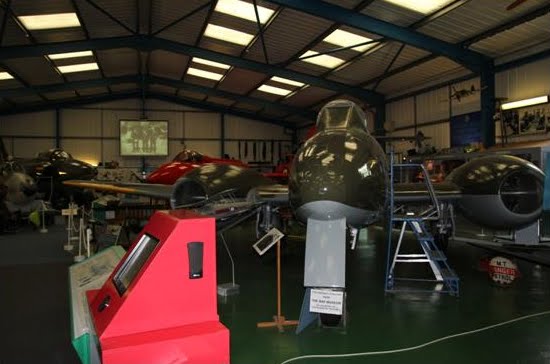A Sortie into Sussex
Now I must admit, my venture didn't start too well. Jane, my eloquent if dogmatic GPS 'controller', who spoke beautifully just before I took over the wheel of the strange little hire car and got back to driving on the left hand side again, got into one of her moods. Abject silence! I pleaded in vain for her to speak up, she leaving me to course through a strange and heaving city with nary a "Turn left" to guide me. But she held her tongue, although I didn't mine, and I may have lapsed into some intemperate and decidedly coarse words, but to no avail. And then to cap it all, my hearing aid failed, just as I had goaded her into action. I pulled into a bus bay, and took several deep breaths. I am sure she gave me a smile when I wasn't looking, and then suddenly she became communicative again, soon after I had inserted another battery into my hearing aid. It was as if cross words had ever passed between us. With that stern, commanding voice of hers that I have grown to love, she put me on the right road to Peterfield!
I was meeting with friends from the old days, who lived in a lick of a small village which I hadn't been unable to find on the map. But clever Jane did, and took me straight to their door. Well, not straight, for much to her chagrin, I wanted to have a look at Peterfield, an important and ancient market town with a large pond on its outskirts, and after the briefest titter of protest, she took me where I wanted to go. The countryside around Peterfield is pretty, set against the shambling South Downs with its wooded hills and verdant fields. It has tiny, twisting, undulating roads, not more than two axe-handles wide, hemmed in by brambles and hedges. I crossed a river which looked more like a rill, and passed some big farmhouses with lots of out-houses, barns, silos and muddy machinery, and of course a ubiquitous red telephone box which once said 'Britain' in Bakelite, but now carries a more nifty little phone.

The village of Stoughton nestled in a fold in the land in West Sussex
It is always good to meet friends from old days when the world was different, and so were we, more so if you can take up where you left off and fill in the gaps over a pub lunch. We followed a narrow, crooked finger of road through a fold in the Wold, and stopped at the C19 Hare and Hounds pub in the appealing village of Stoughton. It was quiet in the pub, and it was hard to imagine it rowdy with the locals on those long summer evenings, when everyone sat outside and nursed a pint or two. But alas, the drizzle had come, so we sat inside, strategically placed, within easy calling distance of the kitchen and the bar. The wholesome pie, with carved chunky chips, washed down with wine and locale bitter, garnished with questions and conversation to breach the years, made the time pass all too quickly. Oh yes, I could live a country life in quiet villages ringed by history and beauty in equal measure, and great galloping towns with facilities, festivals and performances not far away. Chichester, Portsmouth, Southampton and even London, were a most manageable distance away for a day at Lords, or Wimbledon, or shopping, and plenty of great houses and arresting vistas, to show to visitors. Good rambling country, a place to walk a dog and watch village cricket – nay, play it!
Yet even this peaceful spot had been touched by war and the old RAF base at Tangmere was merely a brief burst on the throttle from where we walked to a small, dignified memorial to Bolesiaw Wiasnowalski, 213 Squadron RAF, a 23 year old pilot, formerly of the Polish Air Force, who had been shot down and killed by a Messerschmitt 109 on 1 November, 1940, right at the end of the Battle of Britain. Now all was tranquil, fields in various shades of green, and what looked like a distant lake, but was in fact a field of flax.

St Mary's Church, Stoughton, a blend of Saxon and Norman stonework
We walked down to the valley floor and up the slight incline on the other side, past beautiful stone houses and an ancient Tithe barn, to the church of St Mary dating from the C11, with its Saxon and Norman stonework. The church was, of course, open and my friend who has an expertise in many things 'churchy,' as well as a keen knowledge of local history, made the visit enormously worthwhile. Afterwards, I followed them on the road to Chichester as I was on my way to Tangmere, and ran headlong into the traffic for which Chichester is now also famous! It is a beautiful city, for I have seen it on a few occasions, but its ring-road system has more roundabouts than Pavlova had pirouettes, and what is more, they extend right around the town like a Hadron Collider except that on this one, the particles hardly move at all! I can only conclude that control of traffic is some spiffy, ex-RAF chap with a waxed moustache, who thinks that if he no longer has the planes to circle the airfield, then cars will have to do.

A replica Hurricane, Tangmere's early fighter plane in the Battle of Britain.
Tangmere was once a huge fighter base for the defence of the South Coast, and it played a pivotal role in the Battle of Britain. The fighter ace, Douglas Bader, was a wing commander there, along with many others, including Billy Fiske, the first American WWII fighter ace to be killed in WWII. Tangmere was subjected to numerous German raids, and the local cemetery contains the graves of Allied as well as Axis pilots. It was also a secret operational base for the Special Operations Executive (SOE), which flew agents into France and helped arm the Resistance. After the war, the field was the site of Britain's High Speed Flight unit and two world speed records were set, firstly by a Gloster Meteor, and subsequently by a phone-box red, Hawker Hunter (Paul Duke's plane is in the museum). The station was closed down in 1970 and since then, much of the vast airfield has been returned to the village, and farmland.
I arrived late, so my visit was rushed. It is a terribly tangled museum with items and aircraft crammed into every cranny of the original old hangers. I am sure that you require a good few days to take it all in, especially as there is also an extensive SOE exhibit, with lots of personal stories, and much to read. I listened to the words of a Hurricane pilot, E.J. Brindley, all spoken in calm, modulated Oxbridge English, about how his Hurricane was on fire, he was wounded and already badly burnt, when on trying to exit the cockpit, a German bomber flew in front of him. Brindley climbed back into the seat and managed to bring down the bomber, before bailing out himself. Then followed months of pioneer reconstructive surgery by Sir Archibald McIndoe's burns unit, the fore-runner of what is today's field of plastic surgery. The Hurricane, whom many regard as the 'real' hero of the Battle of Britain, rather than the more glamorous Spitfire, while an incredible aircraft, was also much more vulnerable to fire. With that stoic sense of humour and self-deprecation, of which the Brits are masters, horrific burns injuries were called The Hurricane Rash. Brindley was awarded the Victoria Cross, the only pilot from Fighter Command to be so recognized. He was killed when a Liberator bomber in which he was an observer, was downed over the Bay of Biscay, a few days before the war's end.

World speed record holders, the Meteor and behind it (red) the Hawker Hunter
I cursed at having left myself so little time and wandered quickly, too quickly, past all sort of interesting exhibits. The staff were making ready to leave, all old boys like me, though even older, glasses, grey hair and hearing aids in abundance. I cupped my hand behind my ear, and the old boy of whom I had asked a question, smiled. Relax, he seemed to say, you are among friends, and indeed, he spoke a little more loudly. Others were leaving too, old people as well, and I found myself wondering if museums like this one would really attract the younger generations. That war was so long ago, and besides, anything with a propeller, probably belonged to the Stone Age. Even my journey to Portsmouth showed an investment into 'hands-on' video games and exhibits which gave lots of booms, which I am sure, the hearing aid brigade like me, were at pains to avoid. Reading and looking, no, that was old hat, and I felt for the volunteers who are so dedicated to keeping this museum alive.
I looked quickly at the static display outside, a F5E Phantom, a T33 Shooting Star, helicopters, but it didn't grab me like the 'old world' in the hangers. I moved on. Besides, I still had the Chichester roundabouts to negotiate, again!
Winfred Peppinck is the Tales of the Traveling Editor for Wandering Educators
All photos courtesy and copyright Winfred Peppinck


















